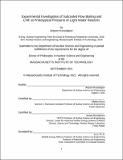Experimental Investigation of Subcooled Flow Boiling and CHF at Prototypical Pressures of Light Water Reactors
Author(s)
Kossolapov, Artyom
DownloadThesis PDF (13.56Mb)
Advisor
Bucci, Matteo
Terms of use
Metadata
Show full item recordAbstract
Boiling crisis is an important phenomenon that affects the performance and safety of pressurized water reactors (PWRs). Accurate predictions of the boiling crisis are difficult to make because they require a clear understanding of the physical mechanisms leading to the boiling crisis combined with accurate models of nucleate flow boiling heat transfer. High-resolution, in situ experiments performed at prototypical pressures of light water reactors (LWRs) are needed in order to elucidate the phenomenon of the boiling crisis and to inform the development of boiling models suitable for LWRs. In the present Thesis, we developed a high-pressure flow boiling experiment together with a new phase detection technique, allowing us to investigate high pressure flow boiling with high spatial and temporal resolutions. We explored aspects of bubble departure, microlayer and triple contact line evaporation, boiling parameters (i.e. nucleation site density, bubble departure frequency, wait and growth times), heat flux partitioning and departure from nucleate boiling. The results reveal that in high pressure flow boiling bubbles depart by sliding immediately after nucleation, with no adhesion force holding a bubble in place. Drag, buoyancy and inertia were identified as the only forces governing bubble departure process. We demonstrated that bubble microlayer disappears entirely for pressures above 3 bar, with its disappearance explained by the decrease in bubble growth rate at higher pressures. The depletion of the microlayer was also analyzed, revealing that both thermal and hydrodynamic effects could be responsible for microlayer depletion process. The analysis of the triple contact line evaporation showed that it cannot account for more than 20% of the total heat flux removed by the boiling surface. Temporal boiling parameters (i.e. bubble departure frequency, wait and growth times) vary considerably between nucleation sites and nucleation events. The distribution of bubble departure frequency is particularly intriguing, since it not only exhibits a power-law, but also reveals an abundance of nucleation sites with extremely low departure frequencies (i.e. in the order of a few hertz). The analysis of the three major heat flux partitioning mechanisms (i.e. evaporation, forced convection and transient conduction) reveal that these mechanisms can only account for 40% to 60% of the total heat flux at the boiling surface, suggesting that either the modeling of these mechanisms does not accurately describe the realistic boiling scenario, or another heat transfer mechanism should be introduced to account for the missing heat flux.
Date issued
2021-09Department
Massachusetts Institute of Technology. Department of Nuclear Science and EngineeringPublisher
Massachusetts Institute of Technology